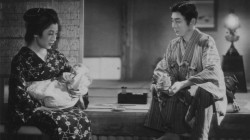Cinema | November 30th, 2016

“The Story of the Last Chrysanthemum” (1939) is an ambitious and idiosyncratic work by master filmmaker Kenji Mizoguchi (1898-1956), based on a stage play adaptation of a novel about Japan’s stylized kabuki theatre. This September the Criterion Collection released to Blu-ray the Shochiku Studios’ new 4k digital restoration of the film.
Mizoguchi was one of Japan’s major directors, making about 75 films from 1923 until his death, but little of his earlier career survives, and he was not well-known outside his native country until the last few years of his life.
His films frequently focused on the plight of women, with a strong female character forced to endure oppression or domination by the male-oriented society, whether ancient or modern. Many are set during the 17th and 18th centuries, although “Last Chrysanthemum” takes place in the late 19th century and others are set in the contemporary era they were filmed in.
After making about 50 films, Mizoguchi felt he had finally become a serious artistic filmmaker with his 1936 productions “Osaka Elegy” and “Sisters of the Gion.” But the film that finally brought him international attention was “The Life of Oharu” (1952), a 136-minute epic tale of a woman’s fall from prestige, which became the first of three consecutive prize winners at the Venice Film Festival. (I reviewed this when Criterion released a Blu-ray edition three years ago.)
The next two years he won for his moving anti-war ghost story “Ugetsu Monogatari” (1953) and his unrelenting portrayal of feudal slavery and the human spirit, “Sansho the Bailiff” (1954).
The Criterion Collection released both “The Life of Oharu” and “Sansho the Bailiff” on Blu-ray in 2013 but so far has released only a DVD version of “Ugetsu,” as well as a four-film DVD set of notable films from 1936 through 1956 called “Mizoguchi’s Fallen Women” (which includes both “Osaka Elegy and “Sisters of the Gion”). For those who prefer Blu-ray, “Ugetsu,” “Osaka Elegy,” “Sisters of the Gion,” and several other Mizoguchi films can be found in Region B-locked editions from Eureka and Artificial Eye in England.
“Osaka Elegy” might easily have been right out of Pre-Code Hollywood with its interesting and perverse look into mid-1930s urban mores and frequent jazz music to match. A pretty young switchboard operator reluctantly decides to become the mistress of her boss so she can help her financially-strapped father who had embezzled company funds for an investment that went bad, and her college-student brother who needs his tuition paid.
Of course she is ostracized from the family for her immorality, without giving her the chance to explain how they got their money. Various other relationships and subplots also come into play.
But such a heavy critique of modern society’s ingrained traditionalist oppression and materialism became more risky by the late 1930s when the country was at war with China and soon to be with the rest of the world. Always more interested in his art than in politics, Mizoguchi went back a half-century for his setting in “Last Chrysanthemum” with a story that was an ode to the distinctively Japanese 17th-century tradition of drama through exaggerated costumes, makeup, song, and dance, called kabuki. Three long segments of the film depict kabuki stage presentations related to the movie’s plot.
The basic plot, however, follows Kikunosuke (Shotaro Hanayagi) the adopted son of a prominent Tokyo kabuki family dynasty, expected to succeed his father as the company’s lead performer. The problem is that he knows he’s not a very good actor and is increasingly depressed at the false praise by others simply due to his name, while the same people ridicule him behind his back. He’s genuinely touched when the family nursemaid Otoku (Kakuko Mori) dares to tell him how bad his latest performance was, yet that she thought he showed promise if he would apply himself instead of basking in his celebrity and living it up.
Naturally he falls in love and defies his family to run off with her so he can make a name for himself. Disowned by his father, he and Otoku quickly learn it is harder than they thought to achieve success using a name unrecognized by the public and they spend five painstaking years in poverty moving from one theatre company to another and eventually with a group of fly-by-night traveling players. Nevertheless, the hardships and Otoku’s devoted support eventually give him the experience he needs for his acting to improve, and there’s an inevitable Hollywood (or Tokyo) tear-jerking ending reminiscent of family melodramas like “Stella Dallas” and others.
The film has a strong element emphasizing family loyalties and reinforcing the cultural class system and Japanese tradition that the government praised, apparently not noticing how the experiences and sympathies of the characters actually repudiate those rigid traditions.
Mizoguchi’s style and structure are as much a part of the film as its story, with his long takes, moving camera, and rare use of close-ups emphasizing the artistry of his handling of actors within the setting. Pacing is substantially slower than American films, but the drama cycles relentlessly on.
Criterion’s Blu-ray has somewhat disappointing image quality, the restoration having access only to a finegrain positive and a duplicate negative instead of the original camera negative. It’s all a bit soft-looking and often dark, generally appearing like a good DVD. Audio is also just okay. Bonus features are simply a flyer with an essay and an on-disc discussion by a critic.
THE STORY OF THE LAST CHRYSANTHEMUM on Blu-ray -- Movie: A / Video: B / Audio: B / Extras: C+
December 29th 2025
December 29th 2025
December 16th 2025
December 9th 2025
December 2nd 2025
_(1)__293px-wide.jpg)
__293px-wide.jpg)
_(1)__293px-wide.png)

_(1)__293px-wide.jpg)
_(1)_(1)_(1)__293px-wide.jpg)